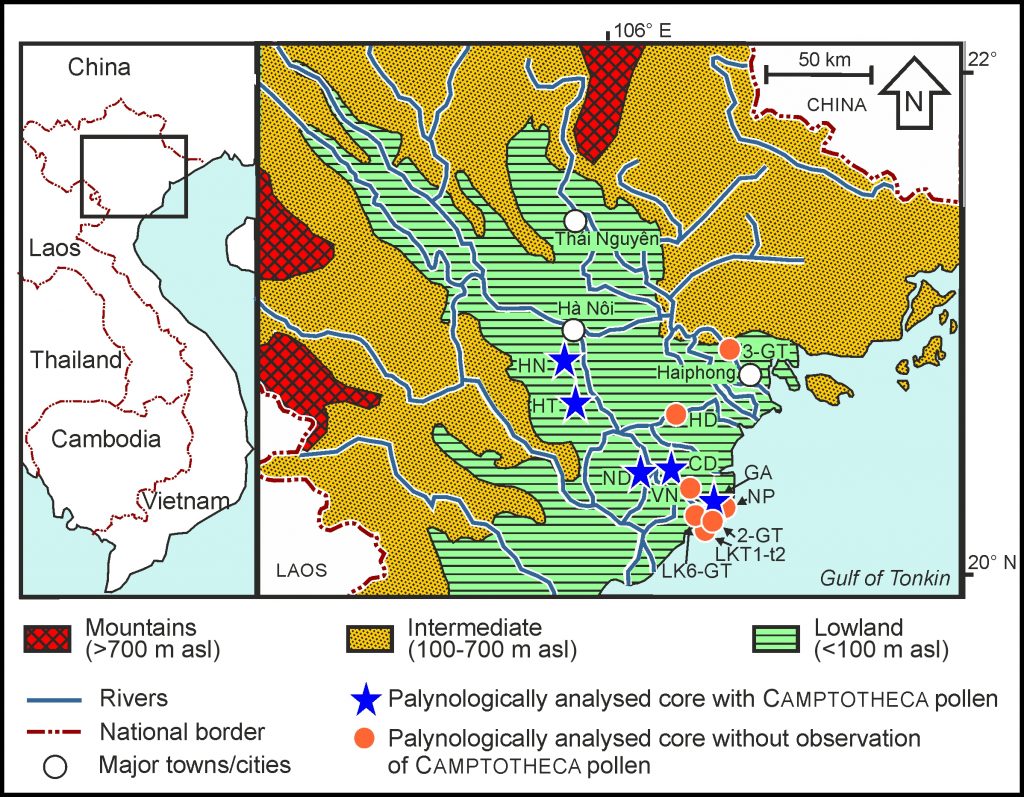Presence of Camptotheca in the Red River Delta (North Vietnam) during the Holocene revealed by pollen analyses
The genus Camptotheca is of great medicinal importance because it contains substances that are effective against various forms of cancer and HIV (Li & Adair 1994; Lorence & Nessler 2004). Currently, Camptotheca is endemic only in central and southern China, and in Tibet. Although its presence in Vietnam has been suspected, botanists have not (yet) found actual specimens in this area (Nguyen Tien Ban 2003).
 Pollen identified as CAMPTOTHECA from core HN, equatorial view (left) and polar view (right). Various photos taken with different focus-levels were edited using the Helicon Focus software (photograph: Martin Theuerkauf).
Pollen identified as CAMPTOTHECA from core HN, equatorial view (left) and polar view (right). Various photos taken with different focus-levels were edited using the Helicon Focus software (photograph: Martin Theuerkauf).
Camptotheca grows frequently in thickets and may reach heights between 20-30 m. It occurs predominantly along forest margins and streams, and on slopes, normally below 1000-1500 m asl., although it occasionally occurs up to 2400 m asl. The genus occurs in regions with high temperatures, high precipitation and high relative humidity and prefers moist and fertile sites on deep, well-drained, friable clay soils (e.g. Li & Adair 1994).
At present, little is known about the Holocene history of the genus. Knowledge on its occurrence and behaviour under natural conditions could provide important information for effective ecological management and, thus, for the most effective plantation for medicinal purposes.
 Map of the Red River delta (N Vietnam) and the locations of relevant palynologically analysed sites. CD (Chuongduong), HN (Hanoi), HT (Hatay), HD (Haiduong) and NP (Namphu) (Nguyen Thuy Duong 2006, 2009; Nguyen Thuy Duong & Nguyen Manh Linh 2011). LK6-GT, LKT1-t2, 2-GT and 3-GT (Dinh Van Thuan et al. 2004). ND-1: (Li et al. 2006a). VN and GA (Li et al. 2006b, 2009).
Map of the Red River delta (N Vietnam) and the locations of relevant palynologically analysed sites. CD (Chuongduong), HN (Hanoi), HT (Hatay), HD (Haiduong) and NP (Namphu) (Nguyen Thuy Duong 2006, 2009; Nguyen Thuy Duong & Nguyen Manh Linh 2011). LK6-GT, LKT1-t2, 2-GT and 3-GT (Dinh Van Thuan et al. 2004). ND-1: (Li et al. 2006a). VN and GA (Li et al. 2006b, 2009).
Palynological analyses in the north-Vietnamese Red River Delta revealed that Camptotheca was present in this area – i.e. outside the range of its current natural distribution – between 6500 and 5300 cal yr BP, and probably also between 7400-6500 and 1400-250 cal yr BP. It possibly occurred during other time-slices as well, but the current data does not yet confirm this. Camptotheca probably followed on Carya, Pterocarya and Salix in a specific stage of riparian tree vegetation development. As the genus is sensitive to shade, wetland forests must have been relatively open, and the development of denser forest during later stages may have surpressed Camptotheca again.
This research is carried out in close cooperation with Nguyen Thuy Duong and Hans Joosten.
Publication:
Nguyen Thuy Duong, de Klerk, P. & Joosten, H. (2015): Presence of Camptotheca in the Red River Delta (North Vietnam) during the Holocene revealed by palynological studies. European Journal of Medicinal Plants 5: 260-271.
Other relevant literature:
Nguyen Tien Ban (editor) (2003): Danh lục các loài thực vật Việt Nam, tập 2 (A list of all plant species in Vietnam, volume 2). Hà Nội: NXB Nông nghiệp.
Dinh Van Thuan, Nguyen Dich Dy, Tri NT & Nguyen Thuy Duong (2003): Thực vật ngập mặn với tiến hóa trầm tích và cổ khí hậu trong Holocen vùng cửa sông Hồng (The mangrove with sediment’s evolution and palaeoclimate in the Holocene in the Red River mouth). Tạp chí Các Khoa học về Trái đất 25: 97-102.
Li, S. & Adair, K.T. (1994): Camptotheca acuminata Decaisne Xi Shu (Chinese Happytree), a promising anti-tumor and anti-viral tree for the 21st century. The Tucker Center, College of Forestry, Stephen F. Austin State University, Nacogdoches, Texas.
Li, Z., Saito, Y., Matsumoto, E., Yongji Wang, Haruyama, S., Hori, K. & Le Quoc Doanh (2006a): Palynological record of climate change during the last deglaciation from the Song Hong (Red River) delta, Vietnam. Palaeogeography, Palaeoclimatology, Palaeoecology 235: 406-430.
Li, Z., Saito, Y., Matsumoto, E., Yongji Wang, Tanabe, S. & Quang Lan Vu (2006b): Climate change and human impact on the Song Hong (Red River) Delta, Vietnam, during the Holocene. Quaternary International 144: 4-28.
Li, Z., Saito, Y., Dang, P.X., Matsumoto, E. & Vu, Q.L. (2009): Warfare rather than agriculture as a critical influence on fires in the late Holocene, inferred from northern Vietnam. PNAS 106: 11490-11495.
Lorence, A. & Nessler, C.L. (2004): Molecules of interest. Camptothecin, over four decades of surprising findings. Phytochemistry 65: 2735-2749.
Nguyen Thuy Duong (2006): Palaeoecology of the Red River Delta in the Holocene: a palynological approach. PhD-Thesis, Greifswald University.
Nguyen Thuy Duong (2009): Palynological investigation from a deep core at the coastal area of the Red River Delta, Vietnam. VNU Journal of Science, Earth Sciences 25: 192-203.
Nguyen Thuy Duong & Nguyen Manh Linh (2011): Kết quả phân tích bào tử, phấn hoa trong hai lỗ khoan vùng Hà Nội và mối liên hệ với biến ðổi khí hậu và hệ thực vật trong Holocene (Characteristics of pollen and spores in sediments of the Hanoi area in relation to climate and vegetation change during the Holocene). Tạp chí Các Khoa Học Về Trái đất 33: 297-305.
Your e-mail address will not be published.